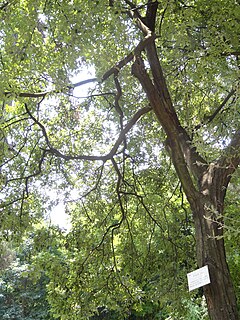
Ligustrum sinense is a species of privet native to China, Taiwan and Vietnam, and naturalized in Réunion, the Andaman Islands, Norfolk Island, Costa Rica, Honduras, Panamá and much of the eastern and southern United States. The name "Chinese privet" may also refer to Ligustrum lucidum.

Campylospermum serratum is a plant in the family Ochnaceae. The specific epithet serratum is from the Latin meaning "with teeth", referring to the leaf margin. It is found in Tropical Asia, from Sulawesi, Indonesia to Hainan, Zhōngguó/China and over to southwester India. Gomphia serrata was a previous common name for the species. The plant is used for it wood and its sap is used in folk medicine and in the past for teeth-blackening.
Plectocomiopsis is a dioecious genus of flowering plant in the palm family found in Indochina, Malaysia, Borneo and Sumatra. Hapaxanthic and armed with spines, they are a climbing rattan, closely related to the Myrialepis palms. The name is Greek for "similar to Plectocomia", another close relative.

Cinnamomum iners is a tree species in the family Lauraceae described by Reinwardt and Blume. No subspecies are listed in the Catalogue of Life. It occurs naturally in Sri Lanka, India, Bangladesh, Myanmar, Thailand, Laos, Cambodia, Vietnam, Malaysia, Indonesia, the Philippines and southern China and south-eastern Tibet.

Dichotomanthes is a monotypic genus of flowering plants belonging to the family Rosaceae. The sole species is Dichotomanthes tristaniaecarpa. The flower is perigynous the ovary is superior. The fruit of the plant is a dry achene.

Engelhardia serrata is a species of tree in the family Juglandaceae. It is native to southwest China, Indo-China, Indonesia, and the Philippines.

Zanthoxylum armatum, also commonly called winged prickly ash in English, is a species of plant in the family Rutaceae. It is an aromatic, deciduous, spiny shrub growing to 3.5 meters in height, endemic from Pakistan across to Southeast Asia and up to Korea and Japan. It is a source of the spice Sichuan pepper, and also used in folk medicine, essential oil production and as an ornamental garden plant

Daphniphyllum macropodum is a shrub or small tree found in China, Japan and Korea. Like all species in the genus Daphniphyllum, D. macropodum is dioecious, that is male and female flowers are borne on different plants. The timber is used in China in construction and furniture making. It is grown as an ornamental plant, chiefly for its foliage.

Anogeissus acuminata is a species of tree in the Combretaceae and has been called axlewood, buttontree or Burmese-derived yon in English. It is now considered a synonym of Terminalia phillyreifolia.

Bombax anceps is a tree species now in the Malvaceae that was described by Jean Baptiste Louis Pierre from its range in Indochina. The subspecies B. a. cambodiense has been reverted to species Bombax cambodiensePierre.

Colona evecta is a tree species, first described by Pierre, in the genus Colona and now placed in the subfamily Grewioideae. No subspecies are listed in the Catalogue of Life.

Spondias pinnata is a species of tree first described by Carl Linnaeus the Younger. It is in the family Anacardiaceae. This species, among several others, has sometimes called the "wild mango" in other languages and was once placed in the genus Mangifera.
Xylopia vielana is a tree species described by Pierre; it is included in the genus Xylopia and family Annonaceae. No subspecies are listed in the Catalogue of Life.

Cleistanthus sumatranus is an accepted name of a tree species in the genus Cleistanthus. No subspecies are listed in the Catalogue of Life.
Garcinia celebica is an accepted name of a tree species in the family Clusiaceae. The Catalogue of Life lists no subspecies.
Garcinia nigrolineata has been called "wild beaked Kandis" and is a tree species in the family Clusiaceae. The Catalogue of Life lists no subspecies.
Colona thorelii is a species small tree, in the family Malvaceae and now placed in the subfamily Grewioideae; it is named after the French botanist Clovis Thorel. No subspecies are listed in the Catalogue of Life.

Ficus fistulosa is an Asian species of fig tree in the family Moraceae. No subspecies are listed in the Catalogue of Life; its native range is Assam to Taiwan, Indo-China, Malesia and New Guinea. The species can be found in Vietnam: where it may be called sung giòn. It is dioecious, with male and female flowers produced on separate individuals.
Utania racemosa is a species of flowering plant in the family Gentianaceae. It occurs in Southeast Asia from Sumatera in Indonesia to the Andaman Islands in India. Its wood is used for timber and fuel.
Helicia nilagirica is a tree of the Proteaceae family. It grows from Thailand across Mainland Southeast Asia to Yunnan, Zhōngguó/China and over to Nepal. It is a source of wood, a pioneer reafforestation taxa, and an ethnomedicinal plant.












